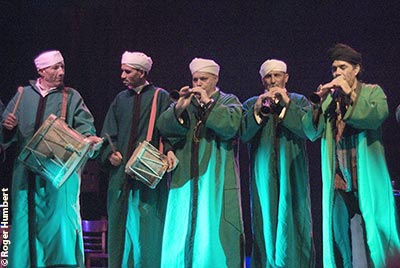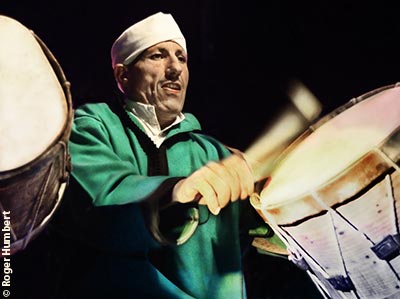|
"The ancient music of Jajouka is as profound and spiraling as DNA. This is the raw genetic material of all sacred music." Genesis P. Orridge, Psychic TV
The history of Jajouka is a long and twisted one. These musicians, based in the Rif Mountains of Morocco, have played the same variation of music — passed on from father to son — for the last 4,000 years, if not more. Being taught the music from early childhood, each musician throughout his lifetime becomes a malim, or a master. The Attar clan of Jajouka is the founding family of the village. They have baraka — the blessing of Allah — which gives them the power to heal. Along with this power, they are blessed with endurance to play their own, particular brand of demanding, intense music — some of the most complex in the world. Legend has it, if they ever stopped playing, the world would come to an end.
Largely kept a local secret, Master Musicians of Jajouka only came to the attention of western ears in the 50’s; due to excitement they generated from Beat poets William Burroughs and Paul Bowles, and painter/innovator Brion Gysin. In fact, Gysin loved the vibe generated by the music so much; he opened up The 1001 Nights restaurant in Tangier. Then, in 1968, he invited Brian Jones (Psychic TV recalled him as “one of the Rolling Stones”) to visit. 1971 saw the release of Brian Jones Presents The Pipes of Pan at Jajouka (re-issued on CD during the mid 90’s), which broke the music wide open to western audiences. Dozens of musicians made the trek to visit the musicians in their Rif Mountain hideaway. During the mid 70’s Ornette Coleman paid a visit to record an all-too brief track for his excellent Dancing in Your Head LP. With the passing of chief bandleader Hadj Abdessalam Attar in 1982, one of his youngest sons Bachir Attar took over the reins of the musical ensemble. Late 80s saw the release of Bachir Attar’s live date with guitarist Elliott Sharp, and only a couple of years later CMP Records released Bachir Attar’s outstanding ‘solo’ project The Next Dream. Bill Laswell’s non-existent imprint Axiom released Apocalypse Across The Sky back in 1992, while since that time Sub Rosa has issued a number of excellent releases.
Due to the excessive costs involved in supporting a large ensemble, Master Musician’s tours have been few. Last time I saw their prowess in town was back in 1995 at the University of Toronto’s Convocation Hall, when they rocked up a riot to an absolutely packed house. Music making was at an all-time high, as they transcended mind and body to deliver a musical package full of twists and turns. Could they live up to that magical night this time around? Was the Phoenix the right venue for them?
We were reminded just how lucky we were to see the troupe live when Bachir Attar announced at the beginning of the performance that his ensemble was only playing a handful of Canadian gigs as they were refused visas to enter the U.S.
|
|
During the first hour of the concert, the musicians were split into two halves. While five played a variety of string instruments, the other four took up a heard of drums. Over the first few minutes, a gentle sense of rhythm was established. As the minutes went by, the beat became hallucinatory, to the point of being menacing. As the listener’s head tried to decipher the grooves, the troupe incessantly pounded on and on. What at first sounded simple — just a hint at melodies and repetitive phrases — turned inward on itself to produce a complex array of shades and colours. With each minute, the rhythm became more menacing as the beat took on new forms of transcendental hypnosis. As the Musicians drew out each individual number, hollering vocals took shape. A variety of call and response and full-frontal vocals took over the room. One adamant concert-goer stood in front of the stage worshipping the music which was offered up. While the musicians appreciated this gesture, it’s a bit of a shame that most people remained firmly in their seats. It wasn’t until the second half that the audience truly opened up its ears to the music. This is when the troupe switched to lira (bamboo flutes) and the ghaita (Arabic oboe).
|
|
|
|
|
The second hour was filled with transcendental melodies that swooped up the brain and seemed to control the body in a firm state of trance. In time, the playing became louder, more intense and even more gripping. One distraction was the over-amplification of the troupe. This is music that should’ve been left alone. In a space the size of the Phoenix, I don’t believe any extra help was needed to bring out the force of the Master Musicians unfiltered to the listeners’ ears. Still, the last half-an-hour of the show saw a large chunk of the audience get up on its feet to meet the musicians in their quest for an eternal state of transcendental majesty. One of the troupe’s members kept on doing a rather uninspired (though credible) dance to encourage the audience to show some sort of emotion. Layered flute-ruckus kept on being replaced by more levels of fuzzy sound that was accompanied by the most primal percussive beat one could imagine. The musicians kept pumping the energy level up to tremendous heights.
If one could encapsulate Master Musicians' performance that night, it would have to be transcendental. This was, is and always will be primal, no-bullshit music that crosses cultural boundaries. Pure in purpose and majestic in its almighty prowess, the Master Musicians of Jajouka performance was in a category of its own — miles above and beyond anything I’ll see for the next hundred years.
|



